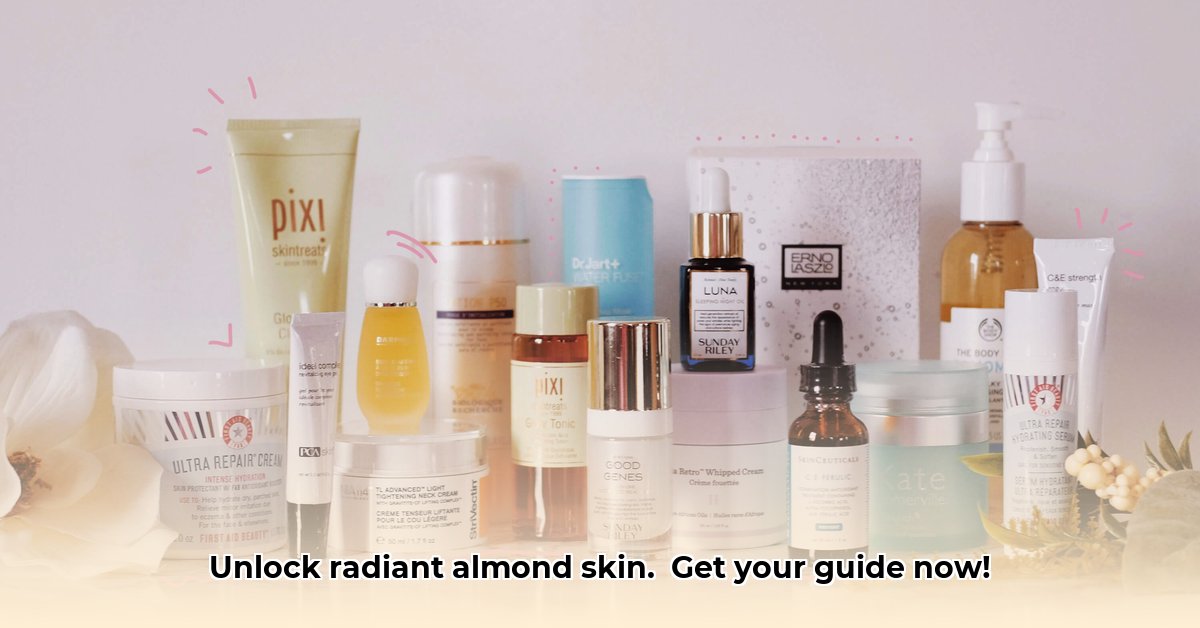Got almond skin? You’re in luck! That beautiful warm, medium-brown tone is gorgeous and versatile, but it needs a little extra love to really shine. This guide is your all-access pass to a skincare routine perfectly tailored for you. We’ll walk you through everything from understanding your skin’s undertones to cleansing, targeted treatments, sun protection, and tackling specific concerns like hyperpigmentation and acne. Think of it as your personal skincare roadmap to healthy, radiant skin. For more detailed information, check out this helpful guide on almond skin tones. Let’s get started!
Skincare Routine for Almond Skin Tone: Your Guide to Gorgeous, Glowing Skin
Almond skin, celebrated for its rich, medium-brown hue, possesses a unique warmth and beauty. But to keep it looking its best and maintain its natural radiance, you need a skincare routine tailored to its specific needs. This guide will help you create a personalized plan, step by step, uncovering the best products and practices to keep your complexion healthy and glowing. Let’s get started on your journey to radiant skin and an even skin tone!
Understanding Your Skin’s Undertones: The Foundation of a Great Routine
Before diving into products, it’s essential to determine your skin’s undertones. This seemingly small detail makes a big difference in choosing the right makeup shades and skincare formulas, especially those with active ingredients. Do you have warm, cool, or neutral undertones? Warm undertones often appear golden, peachy, or yellowish. Cool undertones lean towards pink, red, or blue. Neutral undertones are a balanced mix of both.
Here are a few simple tests to help you uncover your undertone’s hidden identity:
- The Vein Check: Take a peek at the veins on your inner wrist in natural light. Bluish or purplish veins usually hint at cool undertones, while greenish veins often signal warm ones.
- The Jewelry Test: Does gold or silver jewelry make you shine brighter? Gold typically complements warm undertones, creating a harmonious glow; silver tends to bring out the best in cool undertones.
- The White Fabric Test: Hold a pure white piece of clothing or paper next to your face in natural light. Then, try an off-white or cream color. Which one makes your skin look brighter and more even? If white makes your skin look radiant, you likely have cool undertones. If cream is more flattering, you probably have warm undertones.
However, these aren’t exact sciences, and other factors influence your appearance. Pay attention to how different colors make you look – do certain shades make your skin glow more than others? Understanding your undertone isn’t just a fun beauty experiment; it’s essential for choosing makeup and skincare that truly enhances your natural beauty.
Your Daily Skincare Ritual: A Step-by-Step Approach
Your daily routine should be gentle, effective, and enjoyable. Think of it as self-care, not a chore. Consistency is key to seeing results. Here’s a sample plan you can customize for youthful skin over time:
Step 1: The Gentle Cleanse (Morning & Night)
Start and end your day with a gentle cleanser. Harsh cleansers with sulfates can strip your skin of its natural oils, leading to dryness and irritation. Look for cleansers labeled “hydrating,” “gentle,” “for sensitive skin,” or “non-comedogenic” (meaning it won’t clog pores). Consider cleansers containing hydrating ingredients like ceramides, glycerin, or hyaluronic acid. In the evening, a creamy cleanser might be more soothing for removing makeup and daily grime, while a lighter gel might feel better in the morning.
Step 2: Targeted Treatments: Addressing Specific Concerns (Optional)
This is where you tackle specific issues like hyperpigmentation, acne, or fine lines. If you’re dealing with dark spots or uneven skin tone (hyperpigmentation), consider adding a serum with Vitamin C, Niacinamide, or Alpha Arbutin. These ingredients are praised for their brightening and skin-tone evening properties. Always start slowly with new products, applying them a few times a week initially to check for any irritation.
If you experience breakouts, look for products containing salicylic acid or benzoyl peroxide, but remember to patch test these on a small area of skin first. Start with a low concentration and gradually increase as tolerated to minimize dryness and irritation.
For those concerned with fine lines and wrinkles, consider incorporating a retinoid serum or cream into your nighttime routine. Start with a low concentration (0.01% to 0.03%) and use it only a few times a week, gradually increasing frequency as your skin adjusts.
Remember, using these products consistently is key for their efficacy.
Step 3: Hydration, Hydration, Hydration!
Moisturizer is your skin’s best friend, regardless of skin type. Even if you have oily skin, a lightweight, gel-based moisturizer will help balance your skin’s moisture levels. Choose a lotion or cream depending on your skin’s needs and the weather. In the summer months, a light lotion might be preferable, while a richer cream might be more suitable during drier winter months. Look for ingredients like ceramides, shea butter, squalane, or hyaluronic acid.
Step 4: Eye Cream (The Delicate Zone)
Give the delicate skin around your eyes some extra attention with a dedicated eye cream. The skin in this area is thinner and more prone to dryness and wrinkles. Use an eye cream morning and night to hydrate, brighten, and reduce puffiness. Look for ingredients like peptides, caffeine, or antioxidants.
Step 5: Sun Protection: Your Daily Shield
Sunscreen with an SPF of 30 or higher is non-negotiable. UV rays contribute to premature aging, wrinkles, and hyperpigmentation. Protect your skin every day, rain or shine! Find a sunscreen you love—there are options for every skin type, from lightweight gels to tinted moisturizers. Look for broad-spectrum protection, meaning it protects against both UVA and UVB rays.
Step 6: Exfoliation: The Weekly Reveal (1-2 times per week)
Gentle exfoliation helps remove dead skin cells, revealing brighter, smoother skin. Be careful not to overdo it! Over-exfoliating can lead to redness, irritation, and sensitivity. Chemical exfoliants like AHAs (alpha-hydroxy acids) and BHAs (beta-hydroxy acids) are generally gentler than physical scrubs. Start with once a week and see how your skin reacts. AHAs (like glycolic and lactic acid) are great for surface exfoliation and addressing hyperpigmentation, while BHAs (like salicylic acid) penetrate deeper to unclog pores.
Weekly Pampering: Extra TLC for Your Skin
Once a week, treat your skin to some extra love. Incorporate a face mask into your routine to give your skin an extra boost. A hydrating face mask can deeply moisturize and soothe dry skin, while a clay mask helps draw out impurities and clarify pores. A brightening mask can even skin tone and reduce hyperpigmentation. Listen to your skin’s needs; these are meant to complement your daily routine, not to overwhelm it. Experiment to find what works best for you!
Makeup Magic: Enhancing Your Natural Radiance
Makeup can accentuate your beautiful almond skin. Choose foundations that match your undertones perfectly, avoiding those that may appear ashy or too orange. Test different shades along your jawline in natural light to find the perfect match – the one that disappears seamlessly into your skin. Experiment with warm-toned blushes and bronzers to highlight your natural features and add warmth and dimension to your face. Nudes, berries, reds, and corals all look stunning on almond skin tones. Consider your undertone when choosing lip color.
Key Ingredients for Almond Skin: A Closer Look
Here’s a table summarizing some popular skincare ingredients and their potential benefits and drawbacks. Remember that individual reactions can vary, so always patch test new products.
| Ingredient | Benefits | Potential Concerns |
|---|---|---|
| Vitamin C | Brightens, evens skin tone, protects against free radical damage, antioxidant | Can cause initial irritation in sensitive skin; May increase sun sensitivity; Can be unstable. |
| Niacinamide | Reduces hyperpigmentation, improves skin texture, controls oil production, minimizes pores | Can cause redness or dryness in some; May interact with other actives in high concentrations. |
| Hyaluronic Acid | Intense hydration, plumping the skin, reduces the appearance of fine lines | Can draw moisture from the air in humid climates; May require a moisturizer to lock in hydration. |
| Ceramides | Strengthens skin barrier, improves moisture retention, reduces dryness | May feel heavy on oily skin; Effectiveness varies between formulations. |
| SPF 30+ Sunscreen | Protects against sun damage, prevents hyperpigmentation and premature aging | Some sunscreens can feel greasy or leave a white cast; Requires reapplication. |
| Retinoids (Vitamin A) | Addresses fine lines, wrinkles, and acne, promotes cell turnover | Can cause dryness, redness, peeling, and increased sun sensitivity; Use only at night. |
| Alpha Arbutin | Brightens skin, reduces dark spots, evens skin tone | May cause mild irritation in some individuals; Use with sunscreen. |
| Salicylic Acid | Exfoliates, unclogs pores, reduces acne | Can be drying and irritating; Start with a |
- Plant-based Diet Colitis Remission: Success Stories - December 18, 2025
- Plant Based Diet Breast Cancer: Research-Based Benefits - December 16, 2025
- Plant-Based Diet Ulcerative Colitis Remission: Proven Benefits - December 15, 2025










